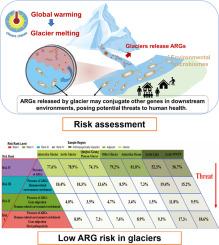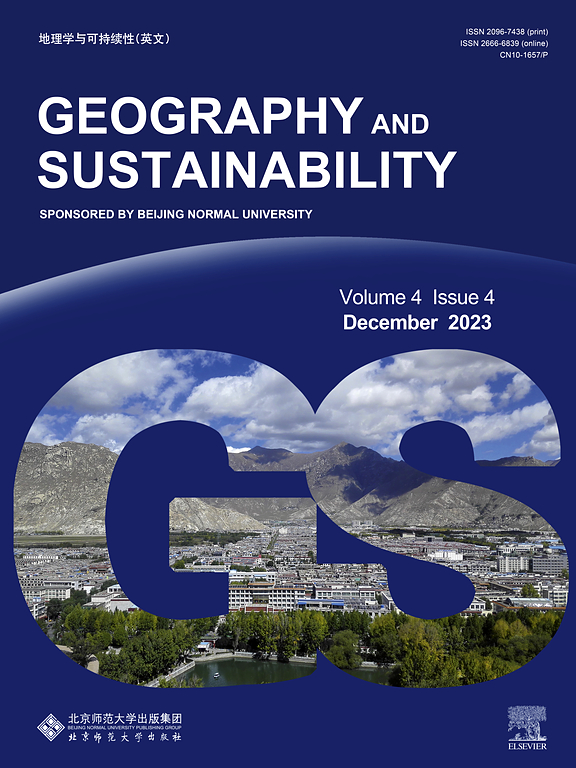Profiles and risk assessment of antibiotic resistome between Qinghai-Xizang Plateau and polar regions
IF 8
1区 环境科学与生态学
Q1 GEOGRAPHY, PHYSICAL
引用次数: 0
Abstract
Antibiotic resistance genes (ARGs) are increasingly recognized as a global public health threat, with glaciers acting as reservoirs for ARGs transported via atmospheric pathways. Warming climate accelerates glacier melting, releasing ARGs into downstream environments, posing ecological health and sustainable aquatic ecosystem development challenges. However, the distribution profiles of ARGs and their risks in glaciers from the polar region remain unclear. This study used 294 metagenomic sequences to investigate the distribution and risks of ARGs in glaciers across the Qinghai-Xizang Plateau, Antarctica, and the Arctic regions and compared them with adjacent and anthropogenically impacted environments. Among the three glacier regions studied, the Qinghai-Xizang Plateau exhibited the highest abundance of ARGs, whereas Antarctica displayed the lowest. ARG abundance in adjacent environments was comparable to that in the glaciers of the Qinghai-Xizang Plateau, but in the anthropogenically impacted environment, it was significantly higher than in glaciers. A shared resistome was identified in glaciers, dominated by bacitracin, multidrug, and macrolide-lincosamide-streptogramin (MLS) resistance genes. The bacA gene, which is related to bacitracin resistance, was the most common subtype, indicating that it is naturally present in microbial communities of glaciers. Risk assessments showed that 74.1 %–78.9 % of ARGs were low-risk in the Qinghai-Xizang Plateau and polar glaciers, indicating minimal human influence. However, 7.3 %–8.0 % were classified as high-risk, posing potential threats through horizontal gene transfer (HGT) and the spread of multidrug-resistant pathogens. These findings highlight the need to monitor ARGs in glacier environments, as climate change accelerates glacier melting and subsequent release of ARGs into downstream ecosystems.

青藏高原与极地地区抗生素耐药组特征及风险评估
抗生素耐药基因(ARGs)日益被认为是一种全球公共卫生威胁,冰川是ARGs通过大气途径运输的储藏库。气候变暖加速冰川融化,向下游环境释放ARGs,对生态健康和水生生态系统可持续发展构成挑战。然而,ARGs的分布概况及其在极地冰川中的风险仍不清楚。本研究利用294个宏基因组序列调查了青藏高原、南极和北极地区冰川ARGs的分布和风险,并将其与邻近环境和受人为影响的环境进行了比较。在研究的3个冰川区中,青藏高原ARGs丰度最高,南极洲最少。邻近环境中ARG丰度与青藏高原冰川相当,但在人为影响环境中,ARG丰度显著高于冰川。在冰川中发现了一个共享的抵抗组,主要是杆菌肽、多药和大环内酯-林科胺-链状gramin (MLS)耐药基因。与杆菌素耐药性有关的bacA基因是最常见的亚型,这表明它自然存在于冰川的微生物群落中。风险评估显示,青藏高原和极地冰川地区74.1% ~ 78.9%的ARGs为低风险,表明人类影响最小。然而,7.3% - 8.0%被列为高风险,通过水平基因转移(HGT)和多重耐药病原体的传播构成潜在威胁。这些发现强调了监测冰川环境中ARGs的必要性,因为气候变化加速了冰川融化,随后ARGs释放到下游生态系统中。
本文章由计算机程序翻译,如有差异,请以英文原文为准。
求助全文
约1分钟内获得全文
求助全文
来源期刊

Geography and Sustainability
Social Sciences-Geography, Planning and Development
CiteScore
16.70
自引率
3.10%
发文量
32
审稿时长
41 days
期刊介绍:
Geography and Sustainability serves as a central hub for interdisciplinary research and education aimed at promoting sustainable development from an integrated geography perspective. By bridging natural and human sciences, the journal fosters broader analysis and innovative thinking on global and regional sustainability issues.
Geography and Sustainability welcomes original, high-quality research articles, review articles, short communications, technical comments, perspective articles and editorials on the following themes:
Geographical Processes: Interactions with and between water, soil, atmosphere and the biosphere and their spatio-temporal variations;
Human-Environmental Systems: Interactions between humans and the environment, resilience of socio-ecological systems and vulnerability;
Ecosystem Services and Human Wellbeing: Ecosystem structure, processes, services and their linkages with human wellbeing;
Sustainable Development: Theory, practice and critical challenges in sustainable development.
 求助内容:
求助内容: 应助结果提醒方式:
应助结果提醒方式:


